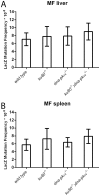The progeroid phenotype of Ku80 deficiency is dominant over DNA-PKCS deficiency
- PMID: 24740260
- PMCID: PMC3989187
- DOI: 10.1371/journal.pone.0093568
The progeroid phenotype of Ku80 deficiency is dominant over DNA-PKCS deficiency
Abstract
Ku80 and DNA-PKCS are both involved in the repair of double strand DNA breaks via the nonhomologous end joining (NHEJ) pathway. While ku80-/- mice exhibit a severely reduced lifespan and size, this phenotype is less pronounced in dna-pkcs-/- mice. However, these observations are based on independent studies with varying genetic backgrounds. Here, we generated ku80-/-, dna-pkcs-/- and double knock out mice in a C57Bl6/J*FVB F1 hybrid background and compared their lifespan, end of life pathology and mutation frequency in liver and spleen using a lacZ reporter. Our data confirm that inactivation of Ku80 and DNA-PKCS causes reduced lifespan and bodyweights, which is most severe in ku80-/- mice. All mutant mice exhibited a strong increase in lymphoma incidence as well as other aging-related pathology (skin epidermal and adnexal atrophy, trabacular bone reduction, kidney tubular anisokaryosis, and cortical and medullar atrophy) and severe lymphoid depletion. LacZ mutation frequency analysis did not show strong differences in mutation frequencies between knock out and wild type mice. The ku80-/- mice had the most severe phenotype and the Ku80-mutation was dominant over the DNA-PKCS-mutation. Presumably, the more severe degenerative effect of Ku80 inactivation on lifespan compared to DNA-PKCS inactivation is caused by additional functions of Ku80 or activity of free Ku70 since both Ku80 and DNA-PKCS are essential for NHEJ.
Conflict of interest statement
Figures




Similar articles
-
Deletion of individual Ku subunits in mice causes an NHEJ-independent phenotype potentially by altering apurinic/apyrimidinic site repair.PLoS One. 2014 Jan 23;9(1):e86358. doi: 10.1371/journal.pone.0086358. eCollection 2014. PLoS One. 2014. PMID: 24466051 Free PMC article.
-
Synthetic lethality between murine DNA repair factors XLF and DNA-PKcs is rescued by inactivation of Ku70.DNA Repair (Amst). 2017 Sep;57:133-138. doi: 10.1016/j.dnarep.2017.07.008. Epub 2017 Jul 26. DNA Repair (Amst). 2017. PMID: 28759779 Free PMC article.
-
A targeted DNA-PKcs-null mutation reveals DNA-PK-independent functions for KU in V(D)J recombination.Immunity. 1998 Sep;9(3):367-76. doi: 10.1016/s1074-7613(00)80619-6. Immunity. 1998. PMID: 9768756
-
Ku, a DNA repair protein with multiple cellular functions?Mutat Res. 1999 May 14;434(1):3-15. doi: 10.1016/s0921-8777(99)00006-3. Mutat Res. 1999. PMID: 10377944 Review.
-
DNA repair factors and telomere-chromosome integrity in mammalian cells.Cytogenet Genome Res. 2004;104(1-4):116-22. doi: 10.1159/000077475. Cytogenet Genome Res. 2004. PMID: 15162024 Review.
Cited by
-
Xrcc5/Ku80 is required for the repair of DNA damage in fully grown meiotically arrested mammalian oocytes.Cell Death Dis. 2023 Jul 5;14(7):397. doi: 10.1038/s41419-023-05886-x. Cell Death Dis. 2023. PMID: 37407587 Free PMC article.
-
Correlation Between the Clinical and Histopathological Results in Experimental Sciatic Nerve Defect Surgery.Medicina (Kaunas). 2025 Feb 11;61(2):317. doi: 10.3390/medicina61020317. Medicina (Kaunas). 2025. PMID: 40005434 Free PMC article.
-
DNA damage-induced degradation of Sp1 promotes cellular senescence.Geroscience. 2022 Apr;44(2):683-698. doi: 10.1007/s11357-021-00456-5. Epub 2021 Sep 22. Geroscience. 2022. PMID: 34550526 Free PMC article.
-
Ku86 alleviates human umbilical vein endothelial cellular apoptosis and senescence induced by a low dose of ionizing radiation.J Int Med Res. 2019 Feb;47(2):893-904. doi: 10.1177/0300060518805302. Epub 2019 Jan 7. J Int Med Res. 2019. PMID: 30616437 Free PMC article.
-
Do DNA Double-Strand Breaks Drive Aging?Mol Cell. 2016 Sep 1;63(5):729-38. doi: 10.1016/j.molcel.2016.08.004. Mol Cell. 2016. PMID: 27588601 Free PMC article. Review.
References
-
- Ahnesorg P, Smith P, Jackson SP (2006) XLF Interacts with the XRCC4-DNA Ligase IV Complex to Promote DNA Nonhomologous End-Joining. Cell 124: 301–313. - PubMed
-
- Grawunder U, Wilm M, Wu X, Kulesza P, Wilson TE, et al. (1997) Activity of DNA ligase IV stimulated by complex formation with XRCC4 protein in mammalian cells. Nature 388: 492–495. - PubMed
-
- Ma Y, Pannicke U, Schwarz K, Lieber MR (2002) Hairpin opening and overhang processing by an Artemis/DNA-dependent protein kinase complex in nonhomologous end joining and V(D)J recombination. Cell 108: 781–794. - PubMed
Publication types
MeSH terms
Substances
Grants and funding
LinkOut - more resources
Full Text Sources
Other Literature Sources
Medical
Molecular Biology Databases
Research Materials

